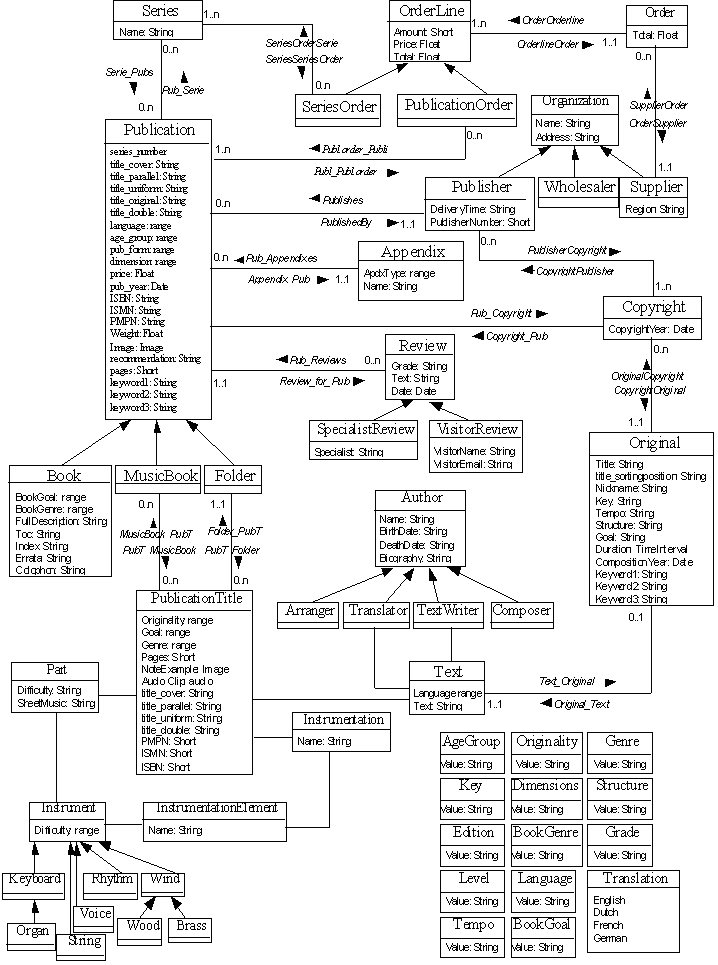| Music Sheet: e-Catalog for Music Notes and their Performing Issuesy* |
Project description:
Music Sheet is a new emerging application in the domain of music notes and their performing
issues. It consists of the design and development of a complete system, which model the
complete life cycle of music production in one general concept. The development phases of
the global concept rises from the lyrics writing phase, to the performing phase, to copyrights
and publishing phase. At the same time it addresses the degree of difficulty, the used
instrumentation, and Intellectual Propriety Rights (IPR) related to music production.
The Music Sheet server, briefly described in this section, provides a catalog
that lets retailers form different music bookstores to search for music books, retrieve music
notes, and place their orders into the system.
Among the highlighted development characteristics of the Music Sheet application are
the extended data model and the flexible search interface. The complete data model allows
the proper structuring of the application and links together related real world entities, while
the flexible search interface provides a mean to navigate through a complex set of data
inter-linked to each other via many relationship associations.
Figure 1 illustrates the data model for the Music Sheet application and shows the
added entities to the data definition concepts, among which music notes, different instrumentation
types, and instrumentation elements are supported. Within this model, music
publications are well defined and classified into several categories of music books and folders.
Each of these publications is composed of a set of titles; a title in turn is composed of several
parts.
The richness of the Music Sheet data model has led to the development of a very flexible
interface for the sheet music application. The search mechanism of the interface uses and
combines several entities as entries to the database system. Search for publication titles and
music notes is based on a combination of author name, title, instrument type, music genre,
keyword, etc. A user for instance, can search for a piece of music notes of genre ‘classic’,
composed by ‘Bach’, and played with both ‘organ’ and ‘string’ instruments.

Fiure 1: Database Model for the Music Sheet Application
 Subscription interface is mandatory when a user decides to order some music books or music titles
Subscription interface is mandatory when a user decides to order some music books or music titles
 Music search interface allows a very flexible entry to the system, in which a user can specify and combine different keywords related to his/her search criterions (e.g. title, composer/author, number, genre, and instrument).
Music search interface allows a very flexible entry to the system, in which a user can specify and combine different keywords related to his/her search criterions (e.g. title, composer/author, number, genre, and instrument).
 Composer search interface explores in more detail information about authors. This interface is accessed via the main list of authors or via direct links from publications and publication titles.
Composer search interface explores in more detail information about authors. This interface is accessed via the main list of authors or via direct links from publications and publication titles.
 Music notes example provides a sample of the music notes available for the publication titles. Usually, those samples are free to download and to print.
Music notes example provides a sample of the music notes available for the publication titles. Usually, those samples are free to download and to print.

Figure 2: Music Sheet User Interface
Advantages gained within the development of the sheet music application:
 The Music Sheet application benefits from the MegaStore concept and adopts its full ordering system.
The Music Sheet application benefits from the MegaStore concept and adopts its full ordering system.
 Publications and publication titles are well defined and more descriptive elements are introduced to their definition. Among these elements, we enumerate music note samples, degree of difficulty, reviewers‘ recommendations, and support for several types of keyword.
Publications and publication titles are well defined and more descriptive elements are introduced to their definition. Among these elements, we enumerate music note samples, degree of difficulty, reviewers‘ recommendations, and support for several types of keyword.
 A clear distinction is made between the different authors participating in the production of a given piece of music. The authors range from text writer or translator, to the music arranger, to the music composer.
A clear distinction is made between the different authors participating in the production of a given piece of music. The authors range from text writer or translator, to the music arranger, to the music composer.
 The system is open for specialists, reviewers, and system visitors to give their comments and recommendation for the different part of the music.
The system is open for specialists, reviewers, and system visitors to give their comments and recommendation for the different part of the music.
 The designed database model is comprehensive enough to express the intellectual propriety rights (IPR) such as text originality, copyrights, and publishing organizations.
The designed database model is comprehensive enough to express the intellectual propriety rights (IPR) such as text originality, copyrights, and publishing organizations.
 The Music Sheet interface provides a very flexible entry to the database based on the combination of keywords from different entities.
The Music Sheet interface provides a very flexible entry to the database based on the combination of keywords from different entities.
 The interface is more dedicated to music bookstore retailers, but it is also simplified and can be used by ordinary users.
The interface is more dedicated to music bookstore retailers, but it is also simplified and can be used by ordinary users.
 The system is extended with a component, which give users the possibility to describe in more details a desired item that it could not be found using the search interface. User requests will be treated by a specialist in the field and results (if any) are sent back to requesting user.
The system is extended with a component, which give users the possibility to describe in more details a desired item that it could not be found using the search interface. User requests will be treated by a specialist in the field and results (if any) are sent back to requesting user.
References
A. Benabdelkader. Information Integration among Heterogeneous and Autonomous Applications, Chapter 4, section 7. ISBN: 90-5776-093-2, Febo Druk, Enschede, 2002. (Thesis 2,512KB).
A. Benabdelkader, H. Afsarmanesh, L. O. Hertzberger. MegaStore: Advanced Internet-based Electronic Commerce Service for Music Industry. In proceedings of 11th IEEE International Conference on Database and Expert Systems Applications - DEXA'2000, Pages 869-878, London - Greenwich, United Kingdom, 2000.
A. Benabdelkader, H. Afsarmanesh, R. Schut, and L.O. Hertzberger. e-MegaStore concept for current music stores models: Free RecordShop, LuisterPaal, and Sheet Music. Poster in ICT KennisCongress, Den Haag, The Netherlands, September 2001.
Contact person
- Ammar Benabdelkader ammar@science.uva.nl
Project members
- University of Amsterdam
- Ammar Benabdelkader
- Hamideh Afsarmanesh
- Bob Hertzberger
- The Frame Holding BV
- Jan Willem Clinge Doorenbos
- Jan Willem Clinge Doorenbos
- International Music Consortium BV
- Frank Geerdes
